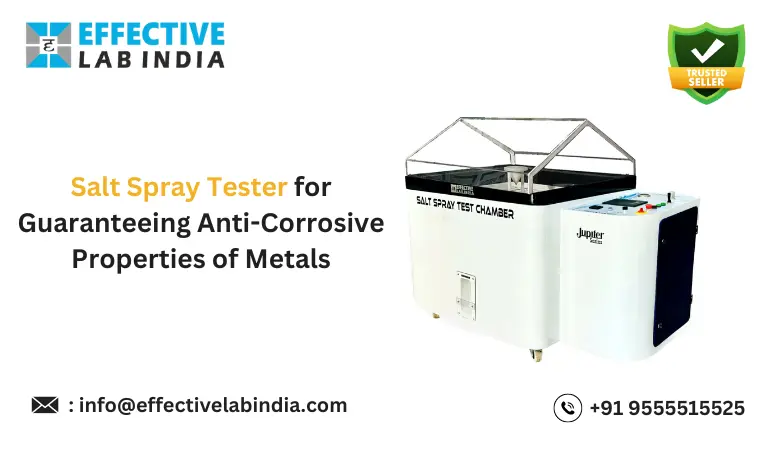Metal products are used in several manufacturing industries. Metal is used due to its durable properties which ensure the longevity of the products and safeguard the products from damage.
But, there are categories in metal that can damage the products. So, before utilizing the metal in production processes, it must be evaluated. Humidity levels are the most carrying challenge faced by manufacturers since the use of metals. Thus humidity is due to diverse atmospheric conditions.
Effective Lab India Understands the issues faced by manufacturers during the production of metal products. To get rid of metal issues, Effective Lab India has offered the best lab testing instrument termed a Salt Spray chamber. This machine is manufactured for conducting a salt spray test with accuracy.
Salt spray test is used for producing a humid environment in a closed chamber which is then used for testing various products.
Now, the question arises in several minds how an artificial humid environment is created in a machine? The answer to your question is only clear by stating the working principle of the Salt spray tester. So, let’s dive into the conduction of this test in a salt spray tester.
Working Of Salt Spray Test Chamber.
In the working mechanism of this machine, a real-world environment is created by insulating the inner chamber.
Depending on the physical characteristics of the specimen, the operator can open the clear canopy and insert the sample into either of the sample holders, (these holders are named as the V group sample rod and card holder). It is crucial to confirm that there is adequate water in both the tank and the air saturator for them to operate correctly before starting the testing requirements.
Next, after the sample is inserted into the chamber, The pre-set timer on the control panel of the salt spray test chamber is programmable by the operator. The reservoir tank, which holds demineralized water that has been filtered using a layer-sponge filter, is where the instrument starts testing in various stages. Salt and DM water are combined to create a solution that is H2O + NaCl. PU pipes and an inlet port opening within the inner chamber are used to transfer the combined solution to the inner chamber. The air saturator is turned on in the second step, which raises the air’s temperature to 45°C and adds humidity. PU pipes and an inlet port help move the air from the air saturator to the inner chamber.
When drying, the energy chamber’s humid air is not released; instead, the silicon bag heaters are activated, raising the chamber’s temperature and drying the sample. Similar to this, an atomizer is used in the humid controlled testing to deliver the salt spray into the inner chamber. The salt is transformed into a concentrated fog by the atomizer. A dispenser helps to evenly distribute the fog inside the energy chamber.
The operator can easily utilize an air purge to quickly lower temperatures, which will cause condensation and eventually settle down all of the artificially manufactured fog inside the testing chamber of the cyclic corrosion tester once the testing has been completed according to the predetermined time on the preset timer. When the fog has cleared, the operator can open the canopy and remove the specimen that was tested to ascertain its uncertainty against certain temperatures when conducted under varying climate conditions. Because of its highly advanced features, which raise testing requirements and encourage one-handed feature testing, the salt spray tester completes tests with remarkable ease and convenience.
Features
A salt spray test chamber consists of a wide range of features that allow the manufacturers to use metal in making their products durable and long-term.
Following are some top-notch features which make the salt spray tester the best choice for manufacturers.
- Robust construction.
- Use of top-quality materials in the manufacturing.
- Flexi glass is used as a canopy.
- The test is conducted under a uniform heating apparatus.
- An automated device which ensures the safety of the operator.
- Alarm systems for overheating.
- Automatic cut-off is another safety feature of this instrument.

